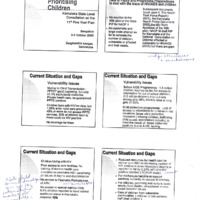Prioritising Children
Item
- Title
-
Prioritising
Children - extracted text
-
SDA-RF-CH-1B.11
Prioritising
Children____
Karnataka State Level
Consultation on the
11lh Five Year Plan
Bangalore
5-6 October 2006
Sanghamitra Iyengar,
Samraksha
• No mention in the
10th plan or the State
PIP for NACP II
j No systematic and
large scale attempt so
far to estimate the
number of children,
vulnerable or affected
and their needs.
Subsequent documents
touch upon it: The Health
Task Force Report (
2001) , the Karnataka
Health Policy Documents
2002) ,the Mid Term
Appraisal of the 10th
plan; NACP III draft PIP
for Karnataka and the
National Consultation on
Children affected or
vulnerable to HIV/AIDS
(2005) but there are gaps
1_A .aa
4
Current Situation and Gaps
Current Situation and Gaps
Vulnerability Issues
Vulnerability Issues
Mother to Child Transmission :
PPTCT good beginning, but only
51.1% institutional deliveries.
Private health care, no guaranteed
PPTC services
School AIDS Programmes : 1.3 million
children reached so far; No access to
information for out of school children;
(3.8 million children) drop out rate
a.rTJ0^9
*^eracy rates among
Children born with HlV:no data, but
1.25% ante- natal sero prevalence.
49% or more do not access PPTC
services; 30% of children born to
these could be HIV positive
No coverage for them
Current Situation and Gaps
J)
r
V ex r
M-p.
"
No access to special nutrition Only
9.4% children reported to have normal
nutritional status in Karnataka.
Anaemia 70%
(2w 1A rQjJ) A*
)i
PL<
Child protection programmes : Lack of
access to information for children in risk
situations; larger child protection
measures ( missing children, trafficking,
child abuse, exploitation) including to
meet the needs of those orphaned/
___ _______destitute due to AIDS, lacking.
Current Situation and Gaps
Children Living with HIV
Poor access to care facilities: No
training of doctors health care
providers on paediatric HIV; sensitising
on issues of stigma and discrimination
access to Paediatric Formulations
Of ARV;
0
f^yvJ ^JkczS'^A^r*"'^
« Reduced resources for health care for
mother and child as increasing number of
HIV positive widows.Household incomejs
reported to fall by 9.24% with one HIV
positive member ( NCAER study) » For mothers,no helpline or support
services; currently no access to creches;
3 For children, parenting and nurture; basic
needs- food shelter, educational access
social inclusion issues
» Care of children from vulnerable
communities ( children of sex workerstrafficked children )
2
z -C-<^s=A>-v e
1
Children affected by HIV
f*5nthl!dV9
- No large scale study capturing the
needs of children; with serial life
events, illness in parents; loss of
one or both parents; sometimes
siblings as well; stigma and
discrimination; often shift of school
and residence; reduction in
income and drop in spending on
basics
b No provisions for care during the
hospitalisation of parents and after
their death
<
P*an
- All children In school by 2003; all
children to complete five years of
schooling by 2007
■ Reduction In Infant Mortality Rate
(IMR) to 45 per 1000 live births by
2007 and 28 by 2012
Doubtful unless the HIV related
Issues are tackled
Recommendations
Recommendations
Key Approach
All measures to protect vulnerable
children from HIV infection
and
to mitigate the impact of HIV on those
living with and affected by HIV so that
they can progress on their path of
normal development
through
the development and support of child /
family-centred, community based
approaches
Child protection to take priority
■ To ensure access to information
and life skills training to all
children but especially those in
difficult circumstances and out of
normal channels for information
flow; like school drop outs,
working children, children of sex
workers, street children and
children orphaned by HIV through
sustained multi-sectoral
programmes
Recommendations
Recommendations
Child protection to take priority
□ To consider establishment &
promotion of child protection help
lines with crisis support teams that
extend their help beyond trafficking
to address different crisis situations
3 To consider PPTC service
access through private and
NGO care providers to ensure
100% coverage
Reducing the Impact on children
living with, and affected by
HIV
■ Immediate procurement and
provision of Paediatric ARTs
at least at all taluka hospitals,
along with training of health care
providers on prescription,
management and adherence
guidelines
« Inclusion of children living with
HIV into schemes for children
with special needs for
nutritional support
x kb
2
Recommendations
Reducing the Impact on children
IMng with, and affected by HIV
• aii existing child development
programmes and institutional
facilities made accessible to
children vulnerable to. living with or
affected by HIV through sensitisation
and special training of care providers
in those programmes.
• Special family support
programmes for hiv positive bpl
families
Recommendations
Reducing the Impact on children
IMng with, and affected by HIV
■ Foster Care Programme to be
extenaed to rural areas ; to include
extended family / community carers.
The programme to be linked with
corwiunity monitoring by women's
■ Development of programmes that
support community counsellors
to provide local support through
crisis situations for children in rural
areas.
3
- Media
 SDA-RF-CH-1B.11.pdf
SDA-RF-CH-1B.11.pdf
Position: 3805 (2 views)
